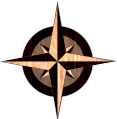April 21, 1863, I immigrated from my native country Sweden with happiness in my soul. Those I left behind were also satisfied that I should leave for a better country as some of them wished to follow in the near future. My brother Lars, was the only one who went with me a little distance. His parting words were: "Please, brother, be faithful." As tears ran down his cheeks we shook hands and I was off for the seaport. I had obtained, through the kindness of my elder brother, Anders, 140 rixdaler ($37.80), enough to pay my journey to Florence on the Missouri River. The company of Saints I traveled with went to Copenhagen, Denmark, Hamburg, Germany, and from there across the North Sea to Grimsby, England, and over the country to Liverpool, where we stopped a few days to get us ready to go abroad the sail ship John J. Boyd, which was to convey us over the great Atlantic.
I was somewhat seasick crossing the mighty deep. My berth was down in the hold, 3rd deck in the ship where all single people above 18 years and under 40 were huddled together, male and female. I and my bunk fellows slept alongside of two young ladies on the right and left of us. The weather was favorable all the way. We saw icebergs and a few whales. We landed in New York, June 1, 1863, after a voyage of 30 days being destitute of money to assist me the next ten days as we now had to board ourselves until we reached Florence. On our journey through the states we saw railroad wrecks and destruction in many places. The Civil War was about to terminate.
Going up the Missouri River from St. Joseph to Florence was the most pleasant trip we had had so far. But soon we were where the Saints had their Winter Quarters when they were driven from civilization. Here were relics of different natures; a house that Brigham Young had lived in, a well that Heber C. Kimball had dug and the remains of the dugouts, camping places and other sacred memories of gone-by times.
We stayed here among the hills and hazel brush for a littler over two weeks, when Captain Sanders with his mountain boys gathered us up and started across the plains. . . . [p.238]
. . . A little this side of the base of the mountains we see the city of Great Salt Lake. It resembles in the distance below something like a village where every house was surrounded by a ten-acre lot. Arrived in the church pasture on Sept. 5, 1863. The next day we looked over the city we had dreamed about.
The picture in our minds of the city, and the real city, failed to have any resemblance. We nevertheless gave it but very little thought. The city itself was nothing to us, we did not own one house or one foot of ground in it, and I for my part, had not a cent even to buy a meal with if I had been wanting one. . . . [p.240]
BIB: Lingren, John, Autobiography, Treasures of Pioneer History comp. By Kate B. Carter, vol. 1 (Salt Lake City: Daughters of Utah Pioneers, 1952) (CHL) pp. 238, 40.
(source abbreviations)
 Saints by Sea
Saints by Sea